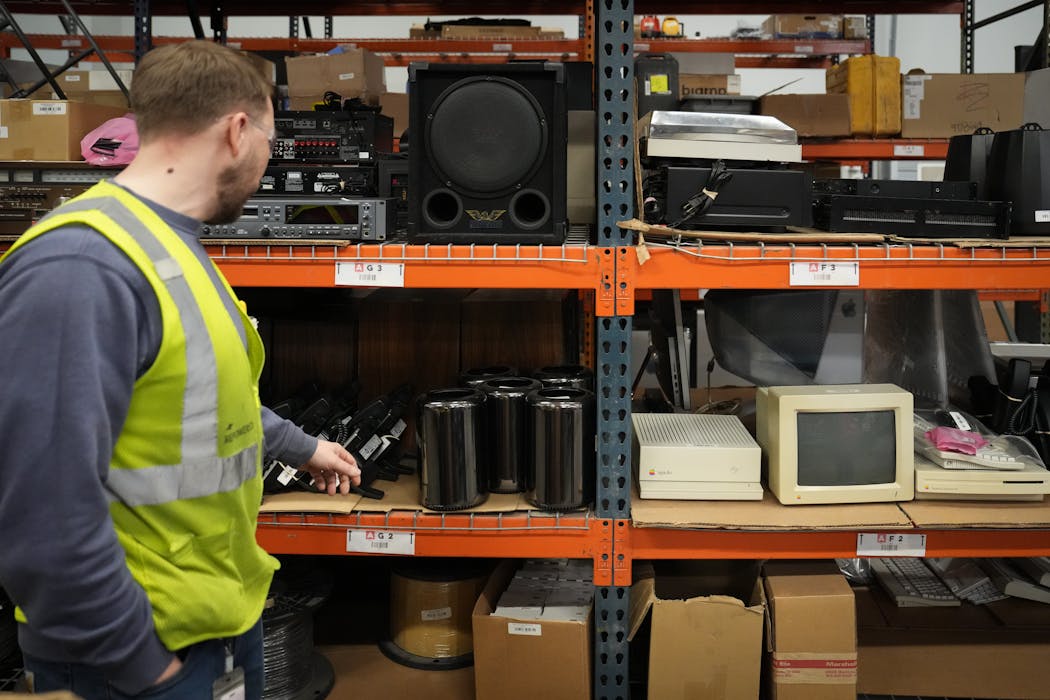Every home seems to have what Sam Drong calls a "pile of denial" — a drawer full of electrical cables that might be useful one day, or old cellphones that haven't been turned on in a decade.
If those cast-offs make it to Repowered, a specialty recycler where Drong works in St. Paul, they can be recycled for parts, or in some cases, refurbished and resold.
Repowered is one of the businesses that state planners consider crucial to cutting down on the metro's trash, which totals 3.3 million tons every year. If thrift stores, refurbishers and repair shops grow as much as the state is hoping, it could also create 15,000 jobs, according to the Minnesota Pollution Control Agency.
But the seven-county metro region's trash problem is so big that one of the key goals of the MPCA is simply to keep the volume of garbage steady over the next two decades, according to a waste management plan released Tuesday. Without significant changes, the amount of trash is expected to grow 20% in that period.
"Preventing the waste from being created in the first place is the best way to keep it out of the landfill," said Kirk Koudelka, an assistant commissioner at the MPCA.
The plan calls for significantly increasing recycling and composting, reducing landfilled waste to 5% of all refuse and continuing to use trash-to-energy plants to burn about 20% of the region's waste.
It offers a menu of options for counties, cities and towns as they build their own waste management systems: Local governments could ban single-use packaging or charge a fee, as Minneapolis does for grocery bags. In other cases, there are mandates: All cities in the metro with a population over 5,000 must offer curbside organics recycling by 2030, including for apartment buildings.
The plan comes as the MPCA is facing a mandate to recycle or compost 75% of the region's garbage by 2030. As of 2022, the rate was about 49%. That's an improvement from the year before, mainly from better handling of food waste and other organic material, Koudelka said.
At the same time, companies in the recycling and reuse sector have struggled. Since 2018, businesses that recycled steel, paper, corrugated cardboard and carpet closed or reduced capacity, according to MPCA.
Koudelka said the supply chain to support reuse and recycling is "something that has to be constantly maintained." He noted that MPCA had gotten $22 million from the Legislature to support these businesses with grants.
One part of the challenge is that consumers and businesses have to get comfortable with buying used items, according to Emily Barker, executive director of nonprofit Reuse Minnesota.
"Part of it is a shift in mentality around IT professionals feeling OK and safe with refurbished stuff," Barker said.
At Repowered, a small store on site had refurbished laptops on sale starting around $100. They come with a one-year warranty, a key selling point to overcome buyers' reluctance, Barker said. The old servers, vacuum cleaners, toasters and other items that come in but can't be recovered are scrapped for parts.
Another challenge will be reducing the mountain of packaging and plastics that is increasingly taking over the waste stream. Several comments on a draft of the MPCA's plan asked whether there were opportunities to limit this waste before it ends up in a trash or recycling bin, or make manufacturers responsible for recycling it. The agency responded to those comments in its latest plan, saying that such measures would likely require legislative action.
Efforts to build new infrastructure have floundered, like Hennepin County's recent decision to scrap its plans for an anaerobic digester, designed to break down organics. The project had received $26 million in state funding, though it came with a caveat: The county also had to make a plan to eventually shutter the Hennepin Energy Recovery Center, or HERC, a trash burner in Minneapolis.
The HERC has been a target for environmentalists who argue it is fouling the air and contributing too much to greenhouse gases. Hennepin County is developing a plan to close it, but that might take until 2040.
Still, the facility keeps 365,000 tons of trash out of landfills each year, and state policy is to use a landfill only as a last resort. Multiple public comments expressed concern about the HERC, and at least one asked MPCA to model the effect on the waste system if it was shut down.
Instead, the agency said it expects Hennepin County to account for what will happen if the HERC stops burning, and to minimize the volume of garbage headed to landfills.
Evan Mulholland, an attorney with the Minnesota Center for Environmental Advocacy, said nothing in MPCA's plan blocks activists' goal of idling the trash burner. And he agreed with the agency's planning requirement: "If you do shut the HERC, you should come up with ways to manage the waste," he said.

Want to share info with the Star Tribune? How to do it securely

'Safe recovery sites' would offer syringes, naloxone and more to people using drugs. The plan could be in peril.
New Minnesota GOP leaders seek peace with party's anti-establishment wing

Who is Republican Lisa Demuth, Minnesota's first House speaker of color?



